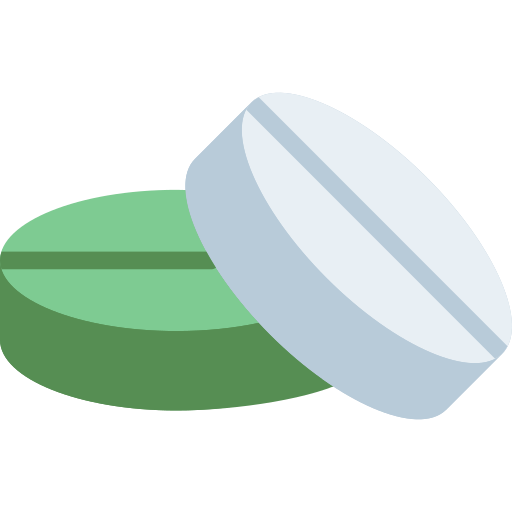
Dexamethasone
0.5 mg
Beximco Pharmaceuticals Ltd.
Product Details
Description
Dexamethasone is a synthetic glucocorticoid which decreases inflammation by inhibiting the migration of leukocytes and reversal of increased capillary permeability. It suppresses normal immune response.
Allergic states: Control of severe or incapacitating allergic conditions intractable to adequate trials of conventional treatment in asthma, atopic dermatitis, contact dermatitis, drug hypersensitivity reactions, perennial or seasonal allergic rhinitis and serum sickness. Collagen disease: Like lupus erythematosus, rheumatoid arthritis etc. Dermatologic diseases: Bullous dermatitis herpetiformis, exfoliative erythroderma, mycosis fungoides, pemphigus and severe erythema multiforme (Stevens-Johnson syndrome). Endocrine disorders: Primary or secondary adrenocortical insufficiency, congenital adrenal hyperplasia, hypercalcemia associated with cancer and nonsuppurative thyroiditis. Gastrointestinal diseases: Regional enteritis and ulcerative colitis. Hematologic disorders: Acquired (autoimmune) hemolytic anemia, congenital (erythroid) hypoplastic anemia (Diamond-Blackfan anemia), idiopathic thrombocytopenic purpura in adults and selected cases of secondary thrombocytopenia. Neoplastic diseases: Leukemias and lymphomas. Nervous system: Acute exacerbations of multiple sclerosis, cerebral edema associated with primary or metastatic brain tumor, craniotomy or head injury. Ophthalmic diseases: Temporal arteritis, uveitis, and ocular inflammatory conditions unresponsive to topical corticosteroids. Renal diseases: To induce a diuresis or remission of proteinuria in idiopathic nephrotic syndrome or that due to lupus erythematosus. Respiratory diseases: Berylliosis, fulminating or disseminated pulmonary tuberculosis when used concurrently with appropriate antituberculous chemotherapy, idiopathic eosinophilic pneumonias, symptomatic sarcoidosis. Rheumatic disorders: As adjunctive therapy for short-term administration (to tide the patient over an acute episode or exacerbation) in acute gouty arthritis, acute rheumatic carditis, ankylosing spondylitis, psoriatic arthritis, rheumatoid arthritis, including juvenile rheumatoid arthritis (selected cases may require low-dose maintenance therapy). For the treatment of dermatomyositis, polymyositis, and systemic lupus erythematosus. Miscellaneous: Diagnostic testing of adrenocortical hyperfunction, trichinosis with neurologic or myocardial involvement, tuberculous meningitis with subarachnoid block or impending block when used with appropriate antituberculous chemotherapy.
Diuretics and/or cardiac glycosides, since potassium loss may be enhanced.This is a particular risk in patients using cardiac glycosides; since hypokalaemia increases the toxicity of these drugs. Antidiabetics, since glucocorticoids may impair glucose tolerance, thereby increasing the need for antidiabetic drugs. Non-steroidal anti-inflammatory drugs, since the incidence and/or severity of gastro-intestinal ulceration may increase. Oral anti-coagulants since glucocorticoids may alter the need for these drugs. Glucocorticoids may be less effective when used concomitantly with liver enzyme inducing drugs,such as rifampicin, ephedrine, barbiturates, phenytoin and primidone. If patients undergoing long-term therapy with glucocorticoids are concomitantly given salicylates, any reduction in glucocorticoid dosage should be made with caution, since salicylate intoxication has been reported in such cases. Antacids;especially those containing magnesium trisilicate,have been reported to impair the gastro-intestinal absorption of glucocorticoids. Therefore, doses of one agent should be spaced as far as possible from the other.
Gastric and duodenal ulcers. Systemic and ophthalmic fungal infections. Viral infections, e.g. varicella and herpes genitalis infections. Viral infections of the eye. Glaucoma. Hypersensitivity to corticosteroids
The following adverse reactions have been associated with prolonged systemic glucocorticoid therapy. Endocrine and metabolic disturbances: Cushing-like syndrome, hirsutism, menstrual irregularities, premature epiphyseal closure, secondary adrenocortical and pituitary unresponsiveness, decreased glucose tolerance, negative nitrogen and calcium balance. Fluid and electrolyte disturbances: Sodium and fluid retention, hypertension, potassium loss, hypokalaemic alkalosis. Musculo-skeletal effects: Myopathy, abdominal distension, osteoporosis, aseptic necrosis of femoral and humeral heads. Gastro-intestinal effects: Gastric and duodenal ulceration, perforation and haemorrhage. Dermatological effects: Impaired wound healing, skin atrophy, striae, petechiae and ecchymoses, bruising, facial erythema, increased sweating, acne. Central Nervous System effects: Psychic disturbances ranging from euphoria to frank psychotic manifestations,convulsions,in children pseudotumor cerebri (benign intracranial hypertension) with vomiting and papilloedema. Ophthalmic effects: Glaucoma, increased intraocular pressure, posterior subcapsular cataracts. Immunosuppressive effects: Increased susceptibility to infections, decreased responsiveness to vaccination and skin tests.
Pregnancy Category C.There are no adequate and well-controlled studies in pregnant women. Corticosteroids should be used during pregnancy only if the potential benefit justifies the potential risk to the fetus. Glucocorticoids appear in breast milk.Mothers taking high dosages of corticosteroids should be advised not to breast-feed
General: The lowest possible dose of corticosteroids should be used to control the condition under treatment.The reduction should be gradual. Cardio-renal: These agents should be used with caution in patients with congestive heart failure,hypertension, or renal insufficiency. Endocrine: Drug-induced secondary adrenocortical insufficiency may be minimized by gradual reduction of dosage. Gastrointestinal: Steroids should be used with caution in active or latent peptic ulcers, diverticulitis, intestinal anastomoses, and nonspecific ulcerative colitis, since they may increase the risk of a perforation. Musculoskeletal: Special consideration should be given to patients at increased risk of osteoporosis (e.g.,postmenopausal women) before initiating corticosteroid therapy. Neuro-psychiatric: An acute myopathy has been observed with the use of high doses of corticosteroids, most often occurring in patients with myasthenia gravis or in patients receiving concomitant therapy with neuromuscular blocking drugs (e.g., pancuronium). Psychic derangements may appear ranging from euphoria, insomnia, mood swings, personality changes, and severe depression, to frank psychotic manifestations.
In order to minimize the potential growth effects of corticosteroids, pediatric patients should be titrated to the lowest effective dose.
Overdosage is unlikely, however, treatment of overdosage is by supportive and symptomatic therapy
-
Support 24/7
Call us anytime -
100% Safety
Only secure payments